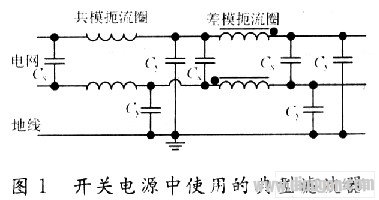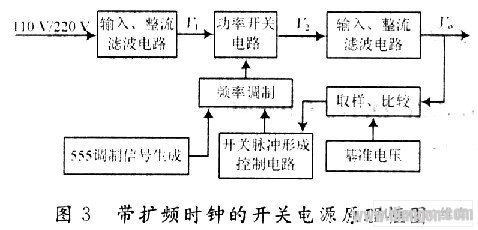Electromagnetic interference (EMI) suppression in switching power supplies is a critical aspect of ensuring stable and efficient operation. The three main factors contributing to EMI are the source of interference, the transmission path, and the device being affected. Therefore, effective EMI suppression must address all three aspects. The goal of improving electromagnetic compatibility (EMC) in switching power supplies is to suppress the interference source, eliminate coupling and radiation between the source and the affected device, and enhance the immunity of the victim device.
1.1 Using Filters to Suppress EMI
Filtering is one of the most effective techniques for suppressing EMI. It can prevent interference from entering the equipment from the power grid and also stop internal EMI from leaking back into the grid. Installing filters in both the input and output circuits of a switching power supply helps manage conducted interference and plays a key role in reducing radiated emissions. Filtering technology can be divided into passive and active types.
1.1.1 Passive Filtering Technology
Passive filters are simple, cost-effective, and reliable. They typically consist of inductors, capacitors, and resistors, and are primarily used to handle conducted emissions. A typical schematic of a passive filter in a switching power supply is shown in Figure 1. Due to the large capacitance in the original power supply circuit, a pulse spike current is generated during rectification. This current consists of high-order harmonics, which can interfere with the power grid. Additionally, when the switch turns on or off, the transformer's primary coil generates a pulsating current, leading to induced currents that may cause differential and common-mode interference. These signals can travel through power lines and affect other devices.

The differential mode filtering part in the figure helps reduce internal differential mode interference and significantly attenuates the EMI generated by the device itself. According to the law of electromagnetic induction, E = L(di/dt), where E is the voltage drop across the inductor, L is the inductance, and di/dt is the rate of current change. A lower rate of current change requires a larger inductance. The pulse current loop can generate common-mode signals due to electromagnetic induction from other circuits. A strong electric field between the switch transistor's collector and other circuits creates displacement currents, which are also common-mode interference signals. The analog filter in Figure 1 is designed to suppress these signals effectively.
1.1.2 Active Filtering
Active filtering is an effective method for suppressing common-mode interference. It involves extracting a compensation signal with the same magnitude but opposite phase from the main circuit to cancel out the original interference. As shown in Figure 2, the base current of a transistor is amplified to filter the emitter current. The R1 and C2 filter reduces base ripple, thus minimizing emitter ripple. Since C2 has a smaller capacity than C3, it reduces the size of the capacitor. This method is suitable for low-voltage and low-power applications. When designing and selecting filters, attention should be given to frequency characteristics, withstand voltage, rated current, impedance, shielding, and reliability. Proper installation location and method are essential for achieving optimal filtering performance.

1.2 Shielding and Grounding Technologies
Shielding is a powerful technique for suppressing electromagnetic radiation from switching power supplies. There are two main types: electrostatic shielding, which protects against static and constant magnetic fields, and electromagnetic shielding, which handles alternating electric and magnetic fields. In a switching power supply, components like transformers, inductors, and power devices can emit electromagnetic waves. These are often shielded using copper or iron plates to reduce interference.
To further reduce radiation and its impact on other devices, overall shielding is recommended. The entire system can be integrated with a grounded casing to provide comprehensive electromagnetic protection. However, challenges such as electromagnetic leakage at joints, input/output ports, and heat dissipation must be addressed. This approach increases structural complexity and cost.
Grounding is crucial for both safety and effectiveness. It ensures that the shielding also acts as electrostatic shielding, enhancing the overall protection. Proper grounding improves the system’s resistance to interference and ensures safe operation.
1.3 PCB Design Techniques
PCB layout, wiring, and grounding play a vital role in suppressing EMI in switching power supplies. To minimize emissions and crosstalk, designers should focus on reducing loop areas, increasing spacing between signal lines, and implementing electrostatic shielding. Grounding is particularly important, with different types such as safety grounding, working grounding, and shielding grounding. The ground wire should be as thick as possible, and AC, DC, and digital grounds should be separated to avoid noise coupling.
1.4 Spread Spectrum Modulation
Spread spectrum modulation spreads the energy of a periodic signal, such as a square wave, over a wider frequency range. This technique reduces the peak emission intensity by distributing harmonic energy more evenly. By modulating the clock signal in the power control circuit, the EMI can be significantly reduced without requiring additional filters or complex shielding. This method is efficient and does not negatively impact power supply efficiency.

1.5 Power Factor Correction (PFC)
PFC technology improves the input current waveform to match the voltage waveform, reducing harmonic distortion and improving the power factor. Passive PFC uses inductors and capacitors to shape the current, while active PFC employs a control circuit to synchronize the input current with the voltage. Both methods increase the power factor, with active PFC offering better performance at the expense of increased circuit complexity.
2. Conclusion
This paper presents a correct design method with valid simulation results, addressing several issues found in traditional schemes. The analysis covers various EMI suppression techniques, including optical isolators, surge absorbers, and soft-switching technologies. The ultimate goal is to minimize electromagnetic pollution while ensuring reliable and efficient operation of switching power supplies. In practical design, a comprehensive approach combining multiple EMI suppression methods is essential to achieve the best results and improve product quality and reliability.
Copper Clad Steel ,Copper Clad Steel Highly Conductive,Copper Clad Steel Strand,Anti-Oxidation Copper-Clad Stee
changzhou yuzisenhan electronic co.,ltd , https://www.ccs-yzsh.com
